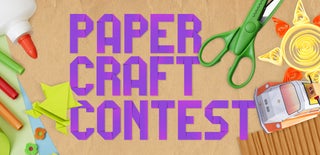Introduction: Cardboard Airplane - From 3D Model to Parade Costume
Inspired by Aidan Chopra's cardboard Grumman F4F-4 costume, we decided to make cardboard airplanes for YuKonstruct's entry in this year's Winterval Santa Clause Parade.
We used free cardboard and YuKonstruct's Epilog laser to make the planes and they were a huge hit with the kids and everyone watching the parade.
We've included the files with this instructables so you can make your own.
Step 1: Design
The planes were designed in SketchUp.
We used an existing 3D model of a cartoon plane from the 3D Warehouse as a starting point.
Having components that are recognized as "solid" objects is really helpful, so the model was completely redrawn and then modified to fit a child and to be able to be cut on a laser cutter with a 20" x 32" bed.
Once we were happy with the modified model, the plane was copied three times so it could be dissected on the x, y and z axis.
We decided to use 3/16" slices as that worked best with the cardboard we had available. The cuts were made using the SketchUp solid tools, specifically the intersect tool. We chose where to make the slices based on what looked good and seemed like it would hold together. We tried to capture the largest points of the shape.
We then had 3 models that were reduced to 2D sheets. The 3 models were then placed on top of one another to see what it would look like and where the sheets would intersect.
Having made each individual slice its own component, copies of each component were laid out flat. The components were each edited to straighten edges and line things up nicely. Since it was copied, the changes made to the components were reflected on the complete model.
The most challenging part of the design was adding the notches as it required figuring out how the pieces should be assembled. The notches were made by drawing the notch on one face of a component and extruding to meet the opposing face.
Once the notches were drawn out, a quick cardstock prototype helped to determine where additional notches and support were needed.
The design was exported to DraftSight as flattened 2D shapes. In DraftSight the components were laid out onto sheets that would fit in the laser cutter (20" x 32"). Once all the components were laid out, the sheets were cut down to the minimum size required. Duplicate lines were then deleted for any components that were touching one another.
Step 2: Prototype
After finishing the design we wanted to test it out in the real world so we made a small prototype 1/8 the size of the final version.
We printed the plans on cardstock and carefully cut out the pieces by hand.
We were pretty happy with the results, so we decided to proceed to the full sized version.
Step 3: Preparing the Pieces
Since we were using cardboard that we got for free (mostly leftover from a kitchen renovation and pulled from a furniture store dumpster) it came in a variety of thicknesses and shapes.
We cut it down into 20" x 20" and 20" x 30" sheets.
To achieve a roughly uniform thickness of 3/16" we glued together the thinner sheets of cardboard with white glue. We let the glued sheets dry while pressed under flat planks of wood to prevent warping.
Once our sheets were ready, we cut them with YuKonstruct's laser cutter.
Each plane takes 10 sheets of cardboard for the 23 pieces.

Step 4: Assembly
The plane pieces can be sorted into 4 groups:
- pieces that run from the front to the back (the red group in the diagram)
- cross pieces that slot into the first group (the yellow group)
- pieces that are inserted horizontally (the blue group), and,
- the propeller and front pieces that are added last (the pink group)

The propeller and ring on the front of the plane need to be glued in place, but the other pieces hold together on their own. We reinforced some seams with hot glue but it is not really necessary.
Step 5: Final Details
Originally we glued the propellers in place but we later decided that we wanted them to be able to spin. To get them to spin,we glued a bolt to the front of the plane and attached the propeller with washers and a nut.
To make the planes wearable we needed to attach straps. The straps were made from 36" lengths of nylon strapping from a set of ratchet straps. We punched holes in the sides of the plane and attached the straps with washers and pop rivets.
Custom vinyl decals were provided by Air North and applied to the wings and tail.
YuKonstruct sky banners were made with tabloid sized pieces of paper and some wire, and were hot glued in place.
Simple LED throwies were used for the wing and tail lights during the parade and were attached with clear packing tape.
Step 6: Finished Plane


Participated in the
Formlabs Contest

Participated in the
3D Design Contest

Participated in the
Papercraft Contest
















